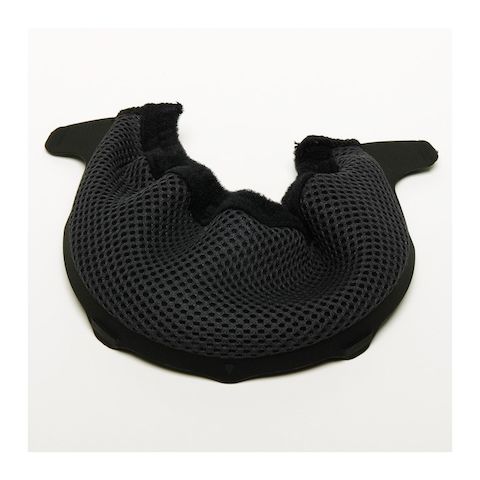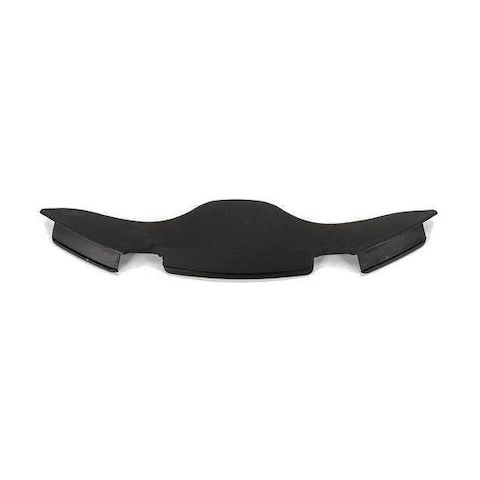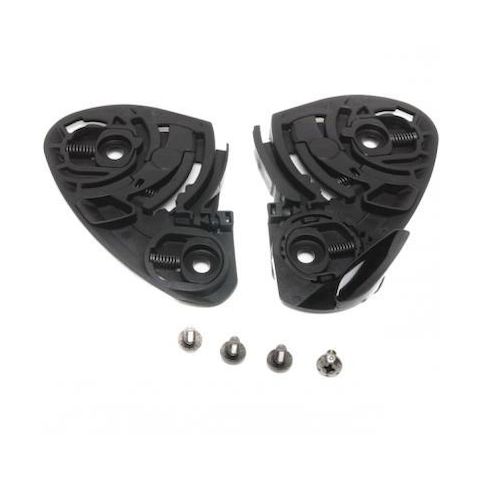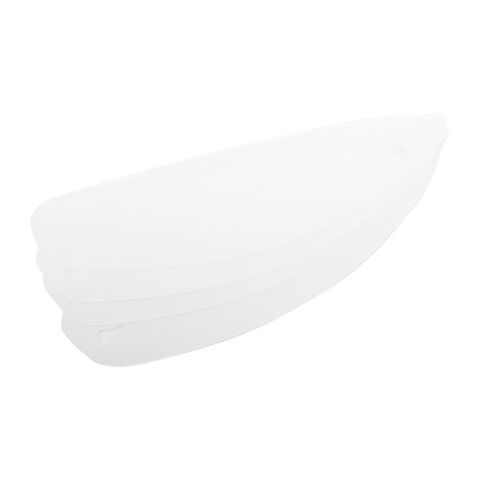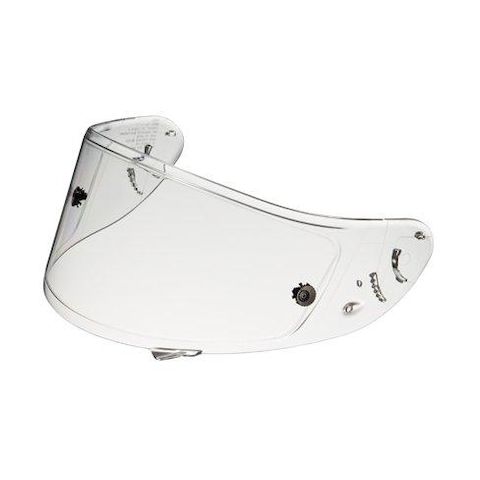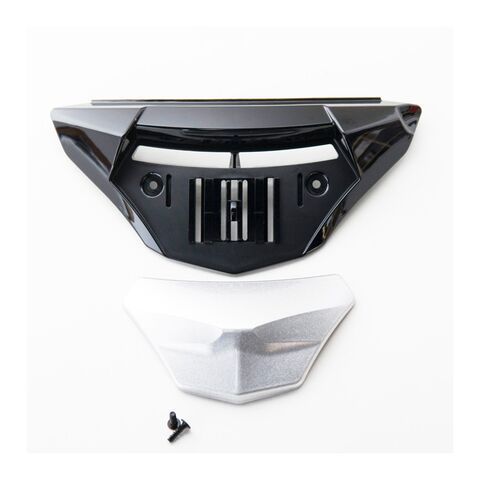With 4 different shells sizes for seven sizes of helmets (2XS-2XL), optimal fit can be acquired without the additional weight and bulkiness that other helmets suffer from. This saves not only size which helps the helmet cut through the wind and decreases buffeting, but also saves weight. The Shoei Qwest Helmet uses the Shoei's CW-1 visor technology with the Q.R.S.A system. This system guarantees a tight seal at the faceshield and an extra-wide viewport for additional peripheral vision.
A lot of people are talking about this helmet. A lot of the more long-distance hypermiling crowd. They're thinking this is a round version of a replacement of the TZ-R from Shoei. That's not true. This helmet, the Shoei Qwest, is going to be the compliment to the RF-1100. So it's a premium price point. You're going to start at 315 bucks. They started at $350 for the solids, go up to $460 for the graphics, but we have everything 10% off. So you're looking $315 for the solids, and $422 for the graphics as a starting point.
What you need to know about this helmet is that it is basically the touring version of the RF-1100. Same shell, it's going to be the AIM plus shell. Carbon fiber, fiberglass, Dyneema composite on the exterior. And as I said, it's Snell 2010. I'm going to pick it up and show you. It's very rigid. I like to do this with all the helmets. You don't want a lot of give here. It's well put together, it's stiff, Snell 2010.
The other piece you need to know is that they have optimized this helmet for long distance touring. What does that mean? It means the vent configuration is going to be higher on the head, knowing that if, with an RF-1100 you're built to be in this position. With a Shoei Qwest helmet you are seated to be in this position. Think about it. You're on a Goldwing, you're on a GX, you're on a KTM90 Adventure. That's an upright riding position. Heck, you could even be standing at some point, depending on the dual supporting you could be doing.
All of the ventilation is sit and aerodynamic properties are built to be in an upright riding position. So notice, we have a top chin vent that's more along the style of the Shoei Multitec, which is a touring modular helmet. As we spin it around from the back here, notice the rear vents, two rear vents... in a different configuration as well. The dynamics of this helmet are built to be very stable, very proportionate and very balanced when you're in this position at highway speed.
Moving down, sharing similarities with the RF-1100. You're going to notice the CW-1 Shield System. The upgraded shield, better periphery. But the nice part, it still has the Shoei quick release system, which I'm going to show you in a second. But the beauty of it is not it's spring-loaded, just like the 1100. So it has strong detents on the way up, but now as you go down, when you get to the bottom you have a spring-loaded piece coming really tight here I want to show you.
Spring-loaded piece up and down. When it gets to that bottom setting it sucks the shield in, creates a better seal at the top gasket. Think about it. If you hit a rain storm, most touring guys ride in all types of weather, you need a strong seal at the top end of this helmet, at the top end of this shield, to block out Mother Nature. This helmet's going to do that. It's an anti-fog shield as well.
So better periphery, different mechanism for the spring-loaded piece, and it's still got that great showy quick-release system which I'm actually going to show you real quick how quickly on and off. You pull it like so, bang, comes right off. Do the other side. Going to push it forward. There's your removable shield. To throw it back on it's very simple. Take it to the top of the range, lock up the first notch, push it in. Lock up the second notch, push it in. Bang, that quick.
Notice you also have that three position lock over here. You have open, you have locked, and then all the way back it's going to be vented. So a quick notch in the thumb, and you're going to get that grey crack at the bottom of the D-5. A lot of people in a different conditions, especially in cold weather, really need that.
Other key different with this helmet, it's going to be slightly rounder. Think about Shoei's fit. Shoei's fit is typically an intermediate oval across their entire range of helmets. What they've done is they have made the crown, as well as the bottom profile of this helmet slightly more round. So it's a more mature audience this helmet's targeting. A hypermiling, a commuter, an adult that really is going to be somebody in their 30's, 40's, 50's wearing this helmet for that type of riding, which we typically see that demographic of.
A lot of times they may have a different head shape, their face might be fuller, there might be more of a round head. This is going to accommodate that. It's not so extreme that it's going to feel like an HJC, where it's a complete Earth shape. But what it is, they've taken that intermediate oval, and they've actually just slightly, slightly rounded it off a little bit so it's more accommodating. It's actually going to fit right in line with the RXQ.
Also with this helmet, even though it is a slightly more rounder shape, you're going to have a little bit more of a gap here in the front. Chin to chin bar ratio, you're going to have more space than the RF-1100. So they've given you more room to operate. Think about if you're installing a communicator on this. It's nice to not have that communicator pressed directly against your lips. That extra clearance is going to help out.
The other thing I want to talk about here is that weight-wise, it's a hair heavier. It's an ounce or two heavier than the RF-1100. Just some of the different features, the way that it's balanced. Also, it's going to be quieter. They've measure this guy. I wore this helmet yesterday and was very impressed. I took it out on the GS, sat in the upright riding position, hit I-95, was doing low triple digits for a little bit.
I really wanted to see how it felt at speed, head-checking, with the vents open. But the big thing that I noticed is it's quieter than my RF-1100. And when I went and looked at the stats, they're actually advertising this helmet to be 1.2 decibels quieter at highway speed. I noticed it right away. So if you're the kind of person that rides with earphones, or likes to have a bluetooth communicator, or doesn't like a lot of noise when you're riding long distances, this helmet's going to be an upgrade over something like the RF-1100.
So now that I have my trusty donut, I'm going to break the helmet down for you. I've already showed you the shield change mechanism. I will note that there's five shell sizes here. When there's five shell sizes, it's the best fit for the size that you're at. You go down to extra small in this guy all the way up to extra large. A lot of range here. And you also, I want to show it, there's a mini chin spoiler here that's built in, and it also comes with the full chin spoiler that comes out of the box.
Unlike the Arai, this chin spoiler doesn't move, and it's non-removable. But it's just a small guy here that you're going to have all the time. So one thing I am going to note is that the topliner, the comfort liner on this guy is not removable, but the cheek pads are. It's three snaps for the cheek pad. One, two, three, and they pull right out. They have very easy tabs. Actually that one was a little loose. You're going to hear all three snaps on this second one. You have one, two, and there should be a third. I do, three. Pop it right there. Pop it right there. That's going to come right out on the back.
Notice on the back here, and the cheek pads are removable and upgradeable. These are 35's, which is typically standard. This is a medium shell-shaped helmet. It's starting at $35. Depending on the shape of your face you can go up or down. But it's very basic here, and I have these great snaps at the front or back, these eyelets. And that's where you know you want to lock those guys up and you hear a click when you put it back in.
Okay now, put this guy down here, show you the guts on the helmet here. It's a brand new one. Just pulled it out of the box. Show you the guts. As I did mention it's a non-removable liner. So you can pull it to a degree, but it's not going to completely remove like the RF-1100, so that is a difference. So let's put these cheek pads back in. So I'm going to slide it in. Basically what I like to do, actually, is I like to line one of the cheek pads up and snap it in, and then it makes it much easier to figure out exactly where the side skirts are supposed to be lined up here. Makes it a bit easier, rather than trying to guess where those mounters are.
So you feel a snap, feel a snap in the front, goes in. You can finish off your snaps here. There's my last one. Right there. And then I can do the same for the other side, show you how quick and easy it is. This is always the harrowing part of these videos, because it can either go really smoothly, or you miss one snap and all the sudden now you're fumbling on camera. So I'm very happy that today it's being very cooperative and it's making me look like a pro at changing this out here.
Snaps in there, goes around the side. Now once you have one snap in, all the rest of your snaps are going to be lined up. Makes it real easy to put the rest in. And there you go. In under a minute I took the cheek pads out. Remember, if you're going to wash it, guys, I say the sink, I say warm, light water.
If they're really funkified you can use a very mild soap. I typically tell people, give them a soak in warm water, give them a little swish with your hand, pull them out, air dry them, they'll last forever. And remember, cheek pads are always replaceable. So if you really funk these guys up in a season, you can always replace them for 20 or 30 bucks.
So four solid colors. There are some metallics. This is the Anthracite Silver, which are going to be $315. And then for the graphics you have three graphics. This is the Etherial I mentioned. It's going to be 10% off. All these are 10% off. This one's going to be $422. All the same features. Just basically a handful of different graphics.
So this is a Shoei Qwest Helmet, Snell 2010, an adventure touring helmet, a compliment to the RF-1100 for long distance touring. But really this helmet came out as a lower price point, head-to-head, bare-knuckle brawl with the Arai RXQ, which from a feature stand point is going to be this guy's big brother. But it's going to go neck-in-neck with it, and it's going to be another great option in the $300 range versus that $450, $500 range.




